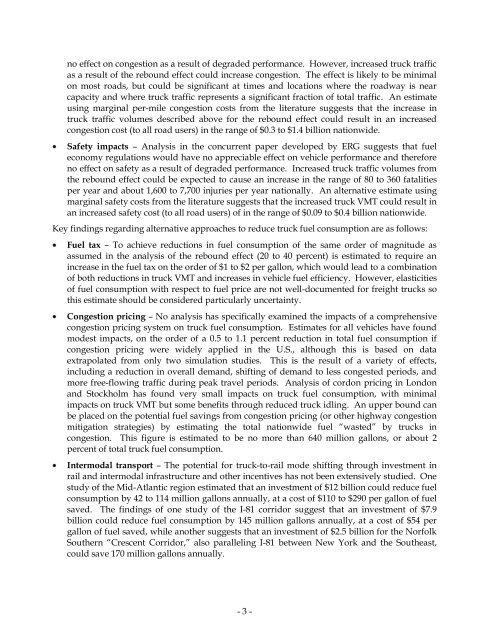Assessment of Fuel Economy Technologies for Medium and Heavy ...
Assessment of Fuel Economy Technologies for Medium and Heavy ...
Assessment of Fuel Economy Technologies for Medium and Heavy ...
You also want an ePaper? Increase the reach of your titles
YUMPU automatically turns print PDFs into web optimized ePapers that Google loves.
no effect on congestion as a result <strong>of</strong> degraded per<strong>for</strong>mance. However, increased truck traffic<br />
as a result <strong>of</strong> the rebound effect could increase congestion. The effect is likely to be minimal<br />
on most roads, but could be significant at times <strong>and</strong> locations where the roadway is near<br />
capacity <strong>and</strong> where truck traffic represents a significant fraction <strong>of</strong> total traffic. An estimate<br />
using marginal per-mile congestion costs from the literature suggests that the increase in<br />
truck traffic volumes described above <strong>for</strong> the rebound effect could result in an increased<br />
congestion cost (to all road users) in the range <strong>of</strong> $0.3 to $1.4 billion nationwide.<br />
Safety impacts – Analysis in the concurrent paper developed by ERG suggests that fuel<br />
economy regulations would have no appreciable effect on vehicle per<strong>for</strong>mance <strong>and</strong> there<strong>for</strong>e<br />
no effect on safety as a result <strong>of</strong> degraded per<strong>for</strong>mance. Increased truck traffic volumes from<br />
the rebound effect could be expected to cause an increase in the range <strong>of</strong> 80 to 360 fatalities<br />
per year <strong>and</strong> about 1,600 to 7,700 injuries per year nationally. An alternative estimate using<br />
marginal safety costs from the literature suggests that the increased truck VMT could result in<br />
an increased safety cost (to all road users) <strong>of</strong> in the range <strong>of</strong> $0.09 to $0.4 billion nationwide.<br />
Key findings regarding alternative approaches to reduce truck fuel consumption are as follows:<br />
<strong>Fuel</strong> tax – To achieve reductions in fuel consumption <strong>of</strong> the same order <strong>of</strong> magnitude as<br />
assumed in the analysis <strong>of</strong> the rebound effect (20 to 40 percent) is estimated to require an<br />
increase in the fuel tax on the order <strong>of</strong> $1 to $2 per gallon, which would lead to a combination<br />
<strong>of</strong> both reductions in truck VMT <strong>and</strong> increases in vehicle fuel efficiency. However, elasticities<br />
<strong>of</strong> fuel consumption with respect to fuel price are not well-documented <strong>for</strong> freight trucks so<br />
this estimate should be considered particularly uncertainty.<br />
Congestion pricing – No analysis has specifically examined the impacts <strong>of</strong> a comprehensive<br />
congestion pricing system on truck fuel consumption. Estimates <strong>for</strong> all vehicles have found<br />
modest impacts, on the order <strong>of</strong> a 0.5 to 1.1 percent reduction in total fuel consumption if<br />
congestion pricing were widely applied in the U.S., although this is based on data<br />
extrapolated from only two simulation studies. This is the result <strong>of</strong> a variety <strong>of</strong> effects,<br />
including a reduction in overall dem<strong>and</strong>, shifting <strong>of</strong> dem<strong>and</strong> to less congested periods, <strong>and</strong><br />
more free-flowing traffic during peak travel periods. Analysis <strong>of</strong> cordon pricing in London<br />
<strong>and</strong> Stockholm has found very small impacts on truck fuel consumption, with minimal<br />
impacts on truck VMT but some benefits through reduced truck idling. An upper bound can<br />
be placed on the potential fuel savings from congestion pricing (or other highway congestion<br />
mitigation strategies) by estimating the total nationwide fuel ―wasted‖ by trucks in<br />
congestion. This figure is estimated to be no more than 640 million gallons, or about 2<br />
percent <strong>of</strong> total truck fuel consumption.<br />
Intermodal transport – The potential <strong>for</strong> truck-to-rail mode shifting through investment in<br />
rail <strong>and</strong> intermodal infrastructure <strong>and</strong> other incentives has not been extensively studied. One<br />
study <strong>of</strong> the Mid-Atlantic region estimated that an investment <strong>of</strong> $12 billion could reduce fuel<br />
consumption by 42 to 114 million gallons annually, at a cost <strong>of</strong> $110 to $290 per gallon <strong>of</strong> fuel<br />
saved. The findings <strong>of</strong> one study <strong>of</strong> the I-81 corridor suggest that an investment <strong>of</strong> $7.9<br />
billion could reduce fuel consumption by 145 million gallons annually, at a cost <strong>of</strong> $54 per<br />
gallon <strong>of</strong> fuel saved, while another suggests that an investment <strong>of</strong> $2.5 billion <strong>for</strong> the Norfolk<br />
Southern ―Crescent Corridor,‖ also paralleling I-81 between New York <strong>and</strong> the Southeast,<br />
could save 170 million gallons annually.<br />
- 3 -
















